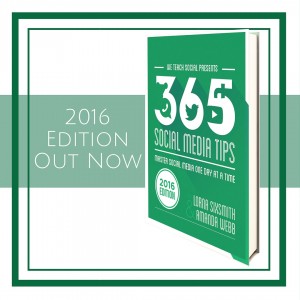Have you set yourself a new year’s resolution to improve your blog (or perhaps start blogging) in 2013. Are you a little disappointed with your blogging results in 2012? Do you want to raise your game? Here’s some tips to follow to improve your blogging success for 2013.
1. Goals & Objectives
As stated by Owen Fitzpatrick in his latest blog post, forget about resolutions (because they suggest that you are applying the same answers again and again to the same problems) and concentrate on your goals and strategies instead. Decide on the goals you wish to achieve with your blog – are you looking for increased sales and bookings? Write down what you want to achieve in numbers. How are you going to achieve those sales? How many times a week are you going to post? Have you decided on your main calls to action?
Before you can ascertain how well your blog will perform, you need to work out what you want it to achieve so write down those goals and what steps you will take to achieve them.
2. Topics / Prevent Writers Block
Once you have established your goals, work out your topics and break them down into blog posts. Not only does this mean that you’re preventing the possibility of writer’s block, you’re also making a headstart with your editorial calendar.
It could be as simple as deciding you wish to increase your wallpaper sales in your interior design store so every Wednesday you will create a ‘Wallpaper Wednesday’ post focusing on a new wallpaper design you will be stocking. Having a regular topic each week keeps you focused too.
I’m going to be offering online courses on social media, for example, pinterest so I’ll be posting short tutorials on pinterest to demonstrate my expertise and to give tasters as to what the courses will entail. Therefore, part of my planning will include regular Pinterest posts offering ‘how to’ tips on how to use Pinterest more effectively for your business.
Brainstorm for topic ideas with colleagues or employees. I recently helped a client to brainstorm ideas for her business blog as she was really struggling for appropriate topic ideas. Within half an hour, we had a list of at least thirty, some of which could be divided into 4 or 5 different posts.
3. Frequency
While it’s forgivable for personal blogs to be updated infrequently if the blogger is busy, a business blog should be updated consistently and regularly. You need to decide how often you can write your blog posts and stick to it. If you have created a blogging calendar or even a list of topics, it’ll make it a lot easier.
Think about how often your readers might like to see content from you too. Posting twice a day is too much for most readers, once a day is great if your content is always good, twice or three times a week is also pretty good as is once a week. Once a month and people may be wondering who you are again when the post pops up in their reader.
Consider how long you spend writing your posts too. I think it is better to post less often and always write good content so your posts could take you 60-90 minutes. How often can you afford that length of time – and how often do you need to post?
4. Optimise Your Posts
Ensure that your blog posts are optimised for keywords that people are searching for in large numbers. There is no point in using a particular phrase as your main keyword if a small people are searching for it per month. Use the free ‘google keyword research’ tool to check.
See our post on ‘How To Use The Google Keyword Tool‘ if you are unsure.
5. Good Quality Photographs
There are many reasons for needing good quality photographs in your blog posts, not least to act to break up the text and to draw the reader’s eye. Good quality photographs are imperative for blogs that are selling products, particularly now that pinterest is growing in influence.
Remember to rename those photographs too, not just for SEO purposes but also for pinterest. If someone pins your blog post, the name of the photograph shows up in the descriptor and it would be much better for your business if it contained the title of your blog post.
If you are making products, be it recipes, crafts or furniture for example, it may be worth taking a photography course. If you are looking for good quality photographs, a site like photopin is a brilliant resource and it makes it very easy to credit your sources too.
See our post ‘How To Make Your Posts More Pinnable‘
6. Value To Customer/Show Your Expertise
Follow the 80/20 rule in that your posts are 20% about you and 80% focused on the customer in that you are focused on solving problems for your potential customers or answering their queries. If I am going to buy a new vacuum cleaner for example, I’d love to read a blog post by the electrical shop giving staff reviews on the best hoovers. If they are written honestly without a big sales pitch and with a simple link to where I can purchase them, you can bet I’d be clicking that link.
Therefore, before you start to write that blog post about a product or service you wish to sell, think about how that product or service can solve your customer’s problem or how they can benefit from using it and you’ve got your blog post.
7. Headlines
The title and first paragraph of your blog post need to be engaging, they have to hook your reader in and they need to show that your post will ‘do what it says on the tin’, that is, provide the information promised in that engaging title. I find that titles that promise ‘How to’ do something or ’8 Tips on’ tend to do well.
See our post ‘How To Write Compelling Headlines For Your Blog‘
8. Calls To Action
If you have a business blog, you’re writing it to increase sales. Your potential customers need to know what you want them to do. When I started blogging in 2008, I didn’t know anything about SEO or including calls to action and the penny finally dropped after a couple of people phoned me wondering if I sold the products I’d just blogged about. Not only had I not showed them where they could purchase the items, I hadn’t made it easy for them.
Almost all of your posts should include a call to action, be it asking for a comment, to like your facebook page, sign up to your newsletter or providing a link to your product.
9. Links
You can’t assume that your readers will visit the page where you’ve included details of all your forthcoming courses so occasionally, if it suits the theme of your post, include the link. If you have written a post on a particular topic in more detail, include the link (just as I’ve done above in a couple of the points). Not only do the links help to keep your reader on your website for longer, the more engaged they become, the more likely they will purchase and/or return again. The building of internal links also help with your website’s SEO too which is another benefit.
10. Track Your Blog and Analyse
Do you look at your analytics often? It’s a good idea to keep an eye on it. All too often, people are not aware of their traffic or where it is coming from. Often, they just like to see how many visitors they get without delving in further. See how much traffic is going to your site from your social media platforms. What is the bounce rate like? If it is high, you need to work out how you can keep people on your website for longer. Is there a particular page that is performing badly? What keywords are working best? Which are your most popular blog posts and why are they performing well?
11. Personality
I referred to the 80/20 rule above, making your content 20% about you and it is important to include some personality into your website and your blog post where it is relevant. If your blog’s aim is to sell more golfing equipment, then you could include a short paragraph on how you got on in a golfing tournament over the weekend. If you are reviewing apps or social media tools, show how you will use them, just as Amanda Webb of Spiderworking has done in her final post of 2012, highlighting the 3 tools she has found most useful of all those she’s reviewed during the year.
You don’t need to tell your readers all about your children or your latest baking attempts but do include information if it is relevant. If you’re creating a recipe book with a section on healthy eating for kids or easy recipes, include details on how your children enjoyed making it with you. Readers will always respond well to personal details and you may find those posts become your post popular ones.
12. Grammar / Spelling
Spelling and grammar is important. Readers will forgive the occasional typographical error and they’ll happen to the best of us. However, regular errors in spelling and grammar suggest sloppiness in general and won’t reflect well on your business acumen. Clients need to know that you will cross the t’s and dot the i’s when dealing with them and if they are not correct in your blog post, it just may turn them away rather than encouraging them to contact you.
See our Post ‘7 Grammar Mistakes & How To Avoid Them‘
13. Customer Service & Community Building
You can demonstrate so much of your company’s level of customer service via your blog. I’m not suggesting that you need to reply to every single comment your receive on your blog particularly if your blog is very popular but replying to some of them and visiting their blogs speaks volumes. If you wish to come across as friendly, helpful, personable and professional, it is very easy to do so via the commenting facility.
The same goes with building communities. For example, food blogging is hugely popular and if your product or service is related to food, it can be very worthwhile getting to know other food bloggers (both online and offline), engaging with them via their blogs and other social media platforms. If you can get other bloggers talking about your business in a positive light, it’s going to be very positive for your business.
and one more!! 14. Publicise Your Blog Post
It’s not just a case of clicking ‘publish’ when you’ve finished your post and expecting people will find it just because it is well optimised. You’ll get more interaction and more traffic if you publicise your post with compelling updates on the various social media platforms, particularly pinterest, twitter and facebook.
Think of your blog as the core of your social media strategy, the centre of a bicycle wheel, and your audience are sitting along that rubber tyre. The spokes are the social media tools to bring your audience to the core, to the blog where the call to action should help to convert them to action.
Photo Credit: Lester Public Library via photopin cc
I hope you’ll find these tips useful as you plan your blogging and social media strategy for 2013. If you are interested in taking a course in social media (from the comfort of your own home or office) do sign up to our newsletter for We Teach Social for updates regarding the launch of various courses.
Happy New Year!










Pingback: U.S. Senate Strikes Deal to Avoid Fiscal Cliff | Small Business Trends
Pingback: U.S. Senate Strikes Deal to Avoid Fiscal Cliff
Pingback: US Senate Strikes Deal to Avoid Fiscal Cliff | iGlobalBlog